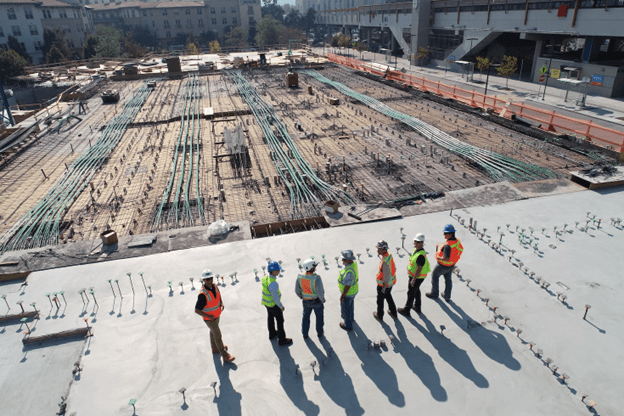The global construction landscape is experiencing large-scale improvements in the fabrication of building materials and designing of structures, thanks to emerging technological innovations. Integrating innovations and technology into your construction project management not only changes how you do your job as a project manager but also helps you mitigate risks while generating new opportunities. Below, we look at the top seven innovative approaches to construction project management.
Use of the Latest Project Management Software
A few decades ago, computer-animated design (CAD) was the only leading technology revolutionizing design. However, greater software tools have emerged. Modern project managers now leverage building information modeling (BIM) in their construction projects. With this, you enable stakeholders and team members to seamlessly collaborate and communicate about the project while accessing models, drawings, files, and other documents in a single dashboard.
The technology further gives you a breath of fresh air by streamlining scheduling and providing your team with real-time updates on project milestones and goals to ensure that you meet crucial deadlines. If you are not yet using BIM software, this is the perfect time to take the plunge.
Pay Attention to Just-in-Time Material Delivery
While finding ways to save on the right construction materials can help lower the project’s overall cost, failing to manage other material issues can skyrocket the costs, leading to losses. Among the issues include material theft at the construction site, damage of materials by forces of nature and inclement weather, and material shortages that lead to construction blockers.
As a project manager, you have to navigate a delicate line between ordering adequate materials for getting the job done or acquiring them in excess and having the materials sit around. The best thing to do is to receive materials you only need for construction at the time from your building product distributors. This will help resolve the challenges resulting from last-minute delivery and lower wastage due to material theft and damage, boosting productivity.
Advanced Estimating and Takeoff Tools
Gone are the days when project managers used spreadsheets to assemble quantity estimates and takeoffs. Construction pros are currently using advanced estimating and takeoff solutions to implement relevant processes more efficiently to achieve greater accuracy.
With these modern tools, you can view and manage bids anywhere, anytime, as well as connect your team and data on a single platform for enhanced collaboration. The tools feature advanced 3D visualization and automation, enabling you to work faster and generate competitive bids. Examples of such tools are Autodesk Takeoff and BuildingConnected.
Use of Wearable Technology to Enhance Safety
Contractors and construction workers increasingly wear sensors to capture real-time data around the work environments, enhancing their safety on site. For instance, the devices can monitor noise levels for a specified time to ensure you do not exceed the safe decibel limits while handling a project.
Alternatively, you can use wearable technology to track air pressure or the emission of hazardous substances into the air. Once you have the information, you can easily track trends and identify where danger is lurking.
Embrace Off-site Manufacturing to Reduce Waste
A rising number of developers and construction project managers are realizing the potential cost savings that result from leveraging off-site building materials. Prefabricated components such as precast concrete elements are an excellent example of off-site manufacturing.
Prefabricated components come in handy with quality assurance, as you can ensure that all the off-site components are of the same standard before using them. Besides that, you can use robots like industrial robots to assemble modular homes or work on bridges, enhancing production speed.
Make Energy Efficiency a Priority
As the United States Continues to eye a net-zero economy by 2050, pressure is mounting on project managers to answer the bell in regard to energy efficiency. Incorporating PV windows, solar panels, water harvesting, and quality interior and exterior wall insulation are among the best ways to develop green buildings.
Even so, you must identify strategies to make a sustainable construction process. Consider investing in modern technology to limit instances of energy-guzzling reworks and boost planning. Think about separating construction waste into compost, landfill, and recycling. In addition, properly store building materials and power off machinery when not in use. You can use prefabrication processes to reduce the time you spend at the site and cut transportation costs.
Leverage Digital Twins
A digital twin is no secret a buzzword with a vast range of benefits for the construction industry. It is basically a digital model of the physical entity with its current and potential assets, workflows, devices, and systems.
In the construction context, digital twins collect data using sensors to study a physical structure and generate its duplicate. You can easily assess, optimize, and manipulate the building with a duplicate copy of the physical structure. It gives you a chance to create efficiencies, reduce risks, improve quality, and develop safety protocols.
You can also use a digital twin to discover if your building meets specific KPIs, metrics, modern innovation trends, and sustainable goals. It is also a perfect tool for obtaining data to inform future decisions depending on the asset performance in the real world.
As the construction industry constantly evolves, new innovations continue to emerge. You must keep up to run cost-effective and sustainable projects. Use these innovative approaches to improve and manage your next construction project successfully.
Oil and gas operations are commonly found in remote locations far from company headquarters. Now, it's possible to monitor pump operations, collate and analyze seismic data, and track employees around the world from almost anywhere. Whether employees are in the office or in the field, the internet and related applications enable a greater multidirectional flow of information – and control – than ever before.











